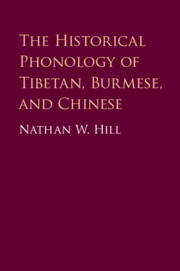Book contents
- The Historical Phonology of Tibetan, Burmese, and Chinese
- The Historical Phonology of Tibetan, Burmese, and Chinese
- Copyright page
- Dedication
- Epigraph
- Contents
- Figures
- Note on Abbreviations and Conventions
- Book part
- Introduction
- 1 Tibetan
- 2 Burmese
- 3 Chinese
- 4 Trans-Himalayan
- Appendix: Complete Lists of Examples
- References
- Index Verborum
- Index Rerum et Nomum
- Index Legum
4 - Trans-Himalayan
Published online by Cambridge University Press: 22 July 2019
- The Historical Phonology of Tibetan, Burmese, and Chinese
- The Historical Phonology of Tibetan, Burmese, and Chinese
- Copyright page
- Dedication
- Epigraph
- Contents
- Figures
- Note on Abbreviations and Conventions
- Book part
- Introduction
- 1 Tibetan
- 2 Burmese
- 3 Chinese
- 4 Trans-Himalayan
- Appendix: Complete Lists of Examples
- References
- Index Verborum
- Index Rerum et Nomum
- Index Legum
Summary
§205. The preceding chapters trace the attested forms of Tibetan, Burmese, and Chinese backwards in time to the greatest extent that currently appears possible. This final chapter compares the results of these three exercises. If all developments in the three languages followed exceptionless phonological patterns with no interference from analogy and lost morphology a few scant remarks would suffice to point out that the backward projection of each of the three languages leads to the self-same result. The true situation is far less elegant. The Trans-Himalayan family is an ancient and ramified one; the three languages studied here offer only fragmentary glimpses of the proto-language.
- Type
- Chapter
- Information
- The Historical Phonology of Tibetan, Burmese, and Chinese , pp. 211 - 258Publisher: Cambridge University PressPrint publication year: 2019

